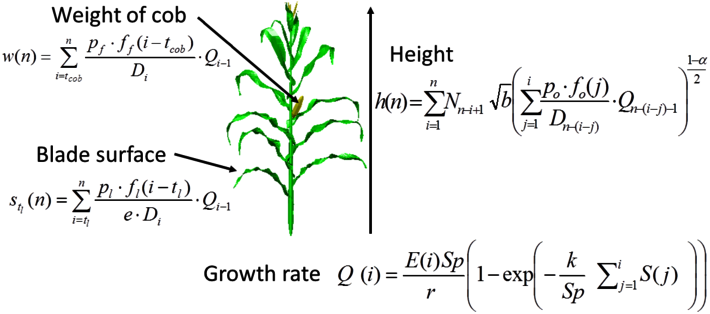Applications
Measurements
Agronomic traits
The GreenLab model in practice
-
In the GreenLab approach, typical agronomic traits should be considered as model outcomes.
In the following example concerning maize, equations corresponding to the following traits are given:
(i) individual organ weight or size,
(ii) plant height,
(iii) total biomass increase per growth cycle.

Common agronomic traits of Maize (Image Y. Guo and Y.T. Ma, CAU)
-
The cob weight at cycle n, w(n) is cumulative biomass production defined by the
supply Qi-1 to demand Di ratio multiplied by the cob sink function
φf(i-tcob). This weight is a simple sum, starting from the appearance date
tcob up to the current cycle n.
The leaf area at a given stage is similar cumulative biomass production, divided by the leaf thickness e; (the leaf appearance date is tl).
The height of the plant, at various cycles, is a classic measurable value. Nk defines the number of internodes in the trunk growth unit present at cycle k. While b and α are allometric parameters.
Fresh plant weight increase is also a classic value of interest. The E function is related to climatic and resource conditions. (1/rl) stands for plant Water Use efficiency. Sp is the plant's projected area, k is the Beer Law extinction coefficient. S(i) is the total functional leaf area at cycle i.
Note that these equations are expressed in their generic formulation.
- On the studied variety, there was just one single cob per plant. w(N),
where Nstands for the growth cycle stage at crop time, therefore gives the final production
value for a given individual.
The organ sink fonctions φorgan are expressed as a product of the sink function forgan() with a conversion factor porgan. The sink function is normalized, i.e. Σ j=ts,te >φorgan(j) = 1, where ts and te define respectively organ appearance and the last functioning dates (expressed as growth cycles).
The height equation stands for any plant, considering Nk on the main axis. In the case of maize (or on any unbranched plant with continuous growth), each growth cycle defines a single internode, i.e. Nk equals 1, simplifying the expression of h(n).
